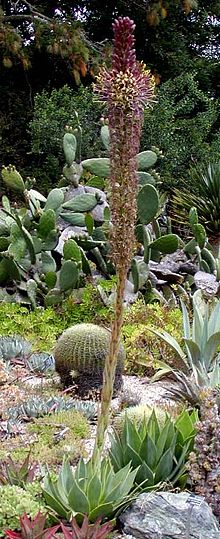
Agave attenuata is a species of flowering plant in the family Asparagaceae, commonly known as the foxtail or lion's tail. The name swan's neck agave refers to its development of a curved inflorescence, unusual among agaves. Native to the plateaux of central west Mexico, as one of the unarmed agaves, it is popular as an ornamental plant in gardens in many other places with subtropical and warm climates.

Agave victoriae-reginae, the Queen Victoria agave or royal agave, is a small species of succulent flowering perennial plant, noted for its streaks of white on sculptured geometrical leaves, and popular as an ornamental.

Agave deserti is an agave native to desert regions in southern California, Arizona, and Baja California. Its tall yellow flower stalks dot dry rocky slopes and washes throughout the spring.

The dark long-tongued bat is a species of bat from South and Central America. It was formerly considered the only species within the genus Lichonycteris, but is now recognized as one of two species in that genus, along with the pale brown long-nosed bat. It is small species of bat, with adults weighing 6–11 g (0.21–0.39 oz) and having a total length of 46–63 mm (1.8–2.5 in).

Agave mitis is a plant species native to the Mexican states of Hidalgo, Tamaulipas and San Luis Potosí, referred to as Agave celsii in many publications.

Craugastor pozo is a species of frog in the family Craugastoridae. It is endemic to Mexico and known from the western foothills and highlands of Chiapas. The specific name pozo refers to the local name of the area near its type locality, El Pozo. Common name Pozo Turipache rainfrog has been coined for it.

Eucalyptus cneorifolia, the Kangaroo Island narrow-leaf mallee, is a native tree of Kangaroo Island, South Australia.

Agave salmiana is a species of the family Asparagaceae, native to central and southern Mexico. It is also reportedly naturalized in South Africa, Italy and Spain, specially in the Canary Islands.

Nepenthes leonardoi is a tropical pitcher plant known from a single locality in central Palawan, the Philippines. It is closely allied to several other Palawan endemics, including N. deaniana, N. gantungensis, and N. mira. The traps of this species reach at least 24 cm in height. Some specimens are noted for producing very dark, almost black, upper pitchers.

Leuenbergeria bleo, formerly Pereskia bleo, is a leafy cactus, native to the shady, moist forests of Central America, that grows to a woody, prickly shrub about 2 m tall with large, orange flowers resembling rose blossoms.

Agave parviflora is a species of succulent perennial flowering plant in the asparagus family, known by the common names Santa Cruz striped agave, smallflower century plant, and small-flower agave. It is native to Arizona in the United States and Sonora in Mexico.
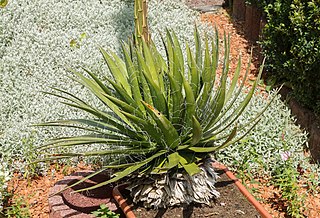
Agave filifera, the thread agave, is a species of flowering plant in the family Asparagaceae, native to Central Mexico from Querétaro to Mexico State. It is a small or medium-sized succulent plant that forms stemless rosette up to 3 feet (91 cm) across and up to 2 feet (61 cm) tall. The leaves are dark green to a bronzish-green in color and have very ornamental white bud imprints. The flower stalk is up to 11.5 feet (3.5 m) tall and is densely loaded with yellowish-green to dark purple flowers up to 2 inches (5.1 cm) long. Flowers appear in autumn and winter.

Agave datylio is a member of the Agavoideae subfamily and a succulent plant. It is native to Baja California Sur.
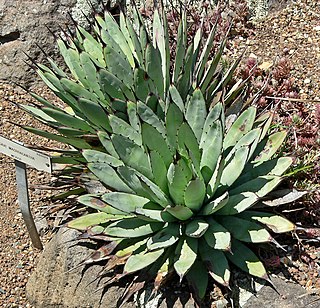
Agave macroacantha, the black-spined agave or large-thorned agave, is a species of succulent flowering plant in the family Asparagaceae naturally occurring in Oaxaca and also near the town of Tehuacan in the State of Puebla, Mexico.
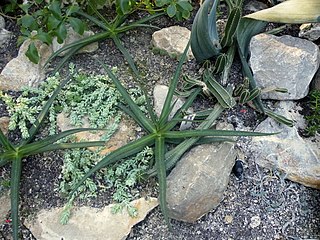
Agave nizandensis is a relatively small member of the genus Agave, in the family Asparagaceae. It is rare species endemic to a small region in the State of Oaxaca in southern Mexico.
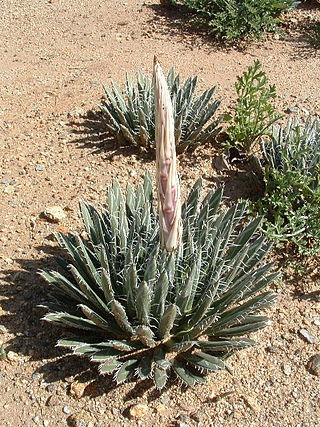
Agave polianthiflora is a relatively small member of the genus Agave, in the subfamily Agavoideae, endemic to northern Mexico.
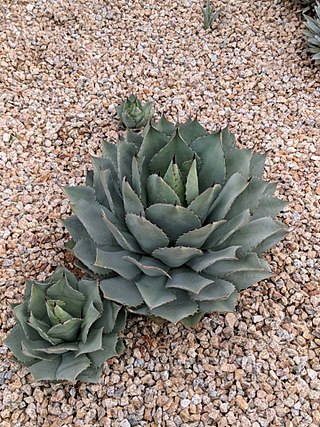
Agave potatorum, the Verschaffelt agave, is a species of flowering plant in the family Asparagaceae. A smallish and attractive succulent perennial, it is native to partial desert areas of Mexico from Puebla south to Oaxaca.
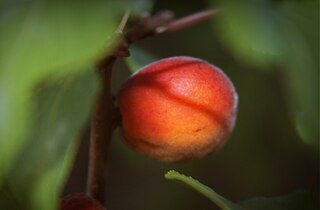
Prunus sibirica, called Siberian apricot, is a species of shrub or small tree native to northern China, Korea, Mongolia, and eastern Siberia. It is in the genus Prunus in the rose family, Rosaceae, one of several species whose fruit are called apricot, although this species is rarely cultivated for its fruit. The species was named by Carl Linnaeus in 1753.
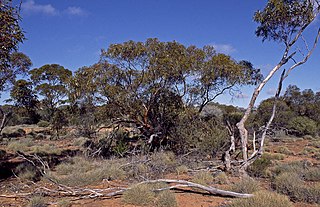
Eucalyptus articulata, also known as the Ponton Creek mallee, is a low, straggly mallee that is endemic to a small area near Kalgoorlie in the Goldfields-Esperance region of Western Australia. It has smooth bark, lance-shaped leaves, flower buds in groups of seven, white flowers and conical fruit.

Agave gigantensis is a large, flowering agave plant found in Baja California Sur, Mexico. Its name is derived from the area of origin, not its large size. The plant is distinguishable by its red and purple leaves during flowering season. It is able to survive in harsh, rocky conditions and prefers dry and warm environments. The flowers of A. gigantensis are arranged in small clusters which diverge from a main branch. Unlike many other agave plants, A. gigantensis has been traditionally used in food and medicine by communities of western Mexico.
